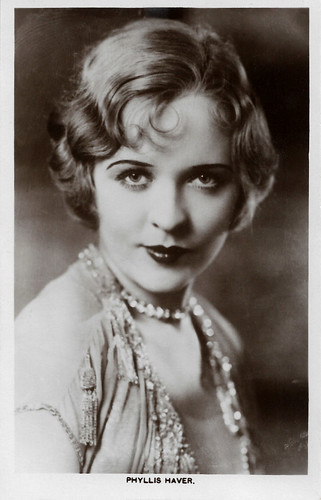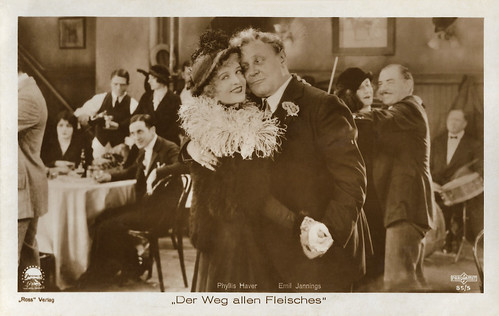
French postcard by Cinémagazine-Edition. Capture: Mack Sennett Comedies.

Italian postcard by G.B. Falci, Milano, no. 271. Photo: Paramount. This is Phyllis Haver, not Belle Bennett. This portrait is from the film Nel gorgo del peccato/The Way of All Flesh (Victor Fleming, 1927) in which the two actresses starred together. Collection: Marlene Pilaete.

British postcard in the Picturegoer Series, London, no. 322.
Astoundingly fine
Phyllis Maude Haver was born in Douglass, Kansas, in 1899 to James Hiram Haver and Minnie Shanks Malone.
When she was a child, her family moved to Los Angeles, California. Phyllis attended Los Angeles Polytechnic High. After graduating, she played piano to accompany the new silent films in local theatres.
Haver auditioned for comedy producer Mack Sennett on a whim. Sennett hired her as one of his original Sennett Bathing Beauties. Between 1916-20 she appeared in more than 35 short films. Within a few years, she appeared as a leading lady in two-reelers for Sennett Studios.
Later, she signed with DeMille-Pathé. She co-starred with George O'Brien and Olive Borden in Fig Leaves (Howard Hawks, 1926) and with Victor McLaglen and Dolores del Rio in What Price Glory (Raoul Walsh, 1926) as the no-better-than-she-ought-to-be Shanghai Mabel.
In 1927, Haver played the part of accused murderess Roxie Hart in the first film adaptation of Chicago, opposite Hungarian film actor Victor Varconi as Amos Hart. The film was produced by Cecil B. DeMille and directed by Frank Urson. Critic Mordaunt Hall called in The New York Times her performance "astoundingly fine," and added that Haver "makes this combination of tragedy and comedy a most entertaining piece of work."

German postcard by Ross Verlag, no. 3729/1, 1928-1929. Photo: DPC.

German postcard by Ross Verlag, no. 4158/1, 1929-1930. Photo: DPC.

Austrian postcard by Iris-Verlag, no. 5362. Photo: Gaumont-Films.
A vampy crook
Phyllis Haver played a vampy crook opposite Emil Jannings in his first American film, The Way of All Flesh (Victor Fleming, 1927). For his role, along with his acting in The Last Command, Jannings won the Oscar for Best Actor in a Leading Role in 1929.
She was directed by the legendary director D. W. Griffith in the comedy film The Battle of the Sexes (1928), also with Jean Hersholt. She appeared with Lon Chaney in his last silent film, Thunder (William Nigh, 1929). Haver made two sound films, the drama The Office Scandal (Paul L. Stein, 1929) and She Couldn't Say No (Lloyd Bacon, 1930), and then retired from the film industry.
In 1929, she married millionaire William Seeman with a service performed by New York Mayor James J. Walker at the home of Rube Goldberg, the cartoonist. She and William moved into an 11-room penthouse in New York City. Phyllis said she loved being a wife and never wanted to return to Hollywood.
After 16 years of marriage, the couple divorced in 1945. Haver had no children. She retired in Sharon, Connecticut. As she grew older Phylis became more reclusive. She lived in a large house and rarely had visitors. Her only companion was her longtime housekeeper. She appeared one last time before the cameras during a 1954 TV testimonial to her old boss Mack Sennett.
She reportedly made several suicide attempts and was very distraught when her old friend and employer Mack Sennett died. In 1960, fourteen days after Sennett's death, Phyllis Haver took her own life with an overdose of barbiturates. She was found in her bed fully dressed and wearing make-up. Haver was 61. She was buried at Grassy Hills Cemetery in Falls Village, CT.

German postcard by Ross Verlag, no. 85/3. Photo: Parufamet. Emil Jannings and Phyllis Haver in The Way of All Flesh (Victor Fleming, 1927).

German postcard by Ross Verlag, no. 85/4. Photo: Parufamet. Emil Jannings and Phyllis Haver in The Way of All Flesh (Victor Fleming, 1927).

German postcard by Ross Verlag, no. 85/5. Photo: Parufamet. Emil Jannings and Phyllis Haver in The Way of All Flesh (Victor Fleming, 1927).
A blond seductress on the train
The Way of All Flesh opens in the early 1900s, Jannings plays August Schiller, a bank clerk in Milwaukee who is happy with both his job and his family. But when bank officials ask him to transport $1,000 in securities to Chicago, he meets a blond seductress on the train, who sees what he is carrying.
She flirts with him, convinces him to buy her a bottle of champagne, and takes him to a saloon run by a crook. The next morning he awakes alone in a dilapidated bedroom, without the securities. He finds the woman, and at first pleads with her, then intimidates her to return the stolen securities. He is knocked unconscious by the saloon owner and dragged to a nearby railroad track.
As the crook strips him of everything that might lead to his identification, Schiller recovers consciousness, and in a struggle, the crook is thrown into the path of an oncoming train and killed. Schiller flees, and in despair is about to take his own life, when he sees in a newspaper that he is supposedly dead, the crook's mangled body having been identified as Schiller's.
The time passes to twenty years later. Schiller is aged and unkempt, employed to pick up trash in a park. He sees his own family go to a cemetery and place a wreath on his grave. Following other scenes in a Christmas snowstorm, Schiller makes his way to his former home, where he sees that the son whom he had taught to play the violin is now a successful musician.
August Schiller walks away, carrying in his pocket a dollar that his son has given him, not recognising that the old tramp is his father.

German postcard by Ross Verlag, no. 4829/1, 1929-1930. Photo: DPG.
Sources: Hal Erickson (AllMovie - page now defunct), Mordaunt Hall (The New York Times), Find A Grave, Wikipedia, and IMDb.
This post ws last updated on 27 August 2024.
No comments:
Post a Comment